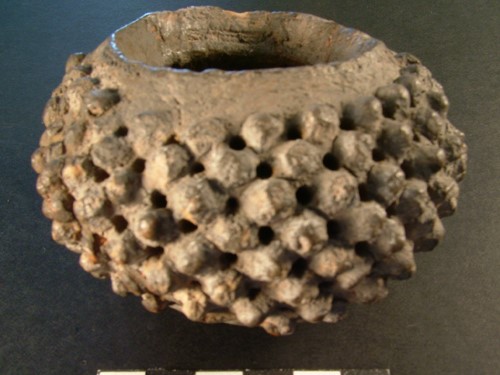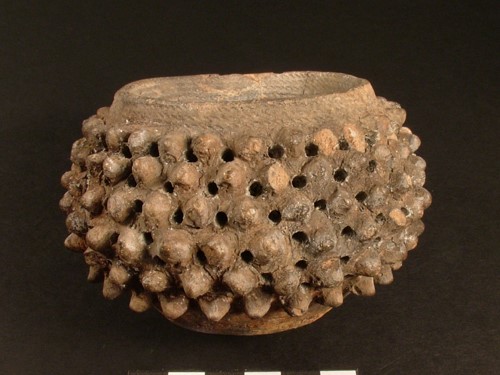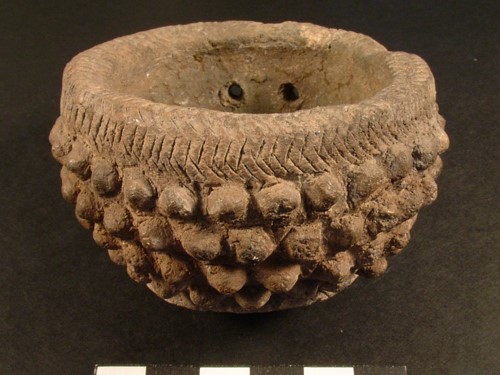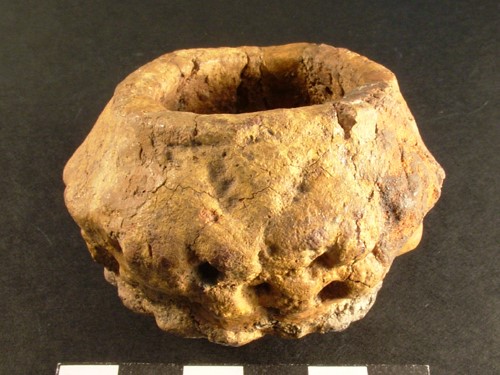The Museum has in its collection several small pottery vessels that belong to a category of small ceramic containers found with Bronze Age burials, known as incense cups. They were given that name by Sir Richard Colt Hoare of Stourhead in his book Ancient Wiltshire published in 1812. Colt Hoare described incense cups as:
“too diminutive to have contained the ashes.. of the deceased. We frequently find them perforated on the sides, and one of them in the bottom, like a cullender (sic) which circumstance induces me to think that they were filled with balsams and precious ointments, and suspended over the funeral pile”.
The grape cups were so called by Colt Hoare because of the small clay nodules which cover their external surface. They have only been found in Wessex, unlike other forms of incense cup, which are more widely distributed. The vast majority were found in Wiltshire. Some have speculated that they may have been used as burners for inducing trance-inducing or fumigating smoke. However, this has yet to be proved scientifically.
Article by Sara Morgan, Archive and Library volunteer.
Grape cup found in bowl barrow Upton Lovell G2e
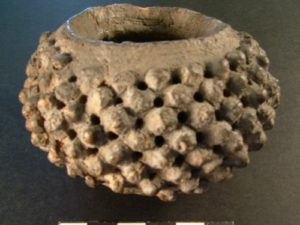

This is the first grape cup to be described in Ancient Wiltshire.
It has eight rows of closely set nodules (208 exactly) each fitting into a hollow in the side with a perforation (often through the side) in between each nodule and lines of minute cord impressions outside and inside the rim. It was found with a secondary cremation, by William Cunnington of Heytesbury in 1803.
Cunnington described the grape cup as -
“a very small urn…. The urn is of a very extraordinary form, appearing exactly as though it had been stuck all over with small black grapes.”
This barrow’s contents were so rich that Colt Hoare called it “The Golden Barrow”. They included gold beads and other ornaments, beads and plates of amber.
Grape cup found in Bronze Age barrow Wilsford G7
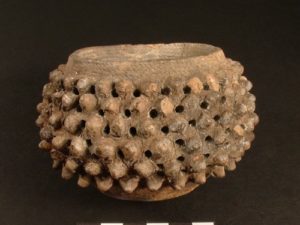

The Wilsford G7 grape cup, described in the Museum’s catalogue as “the finest of its type”, was discovered in a bowl barrow, Wilsford G7, which was excavated by William Cunnington in 1808.
It is decorated with six bands of nodules (each set in a hollow in the cup) with perforations in between them (some through the sides) and thin lines of impressed cord around the inner and outer rim.
It was found with the remains of a skeleton with the head towards the west, and according to Colt Hoare “a deposit of various elegant little trinkets”. These included amber pendants, shale beads including a double-axe bead, gold spherical beads, encrenites, and a richly decorated collared urn at the feet of the skeleton which perhaps contained a food offering. Some argue that assemblages of this type, with no weapon included, may indicate that the skeleton was of a woman. However, Cunnington always reinterred any skeletal remains he discovered, and in the absence of bones there can be no certainty about the sex of the person buried.
Grape cup found in bowl barrow Amesbury G19a
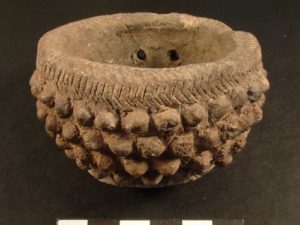

This is decorated with four bands of tiny nodules around the sides and one band of fingernail impressed herringbone chevrons around neck, rim and base (and perforated twice inside for suspension), and was found with a primary cremation by William Cunnington. “A very beautiful and perfect grape cup” according to Colt Hoare.


